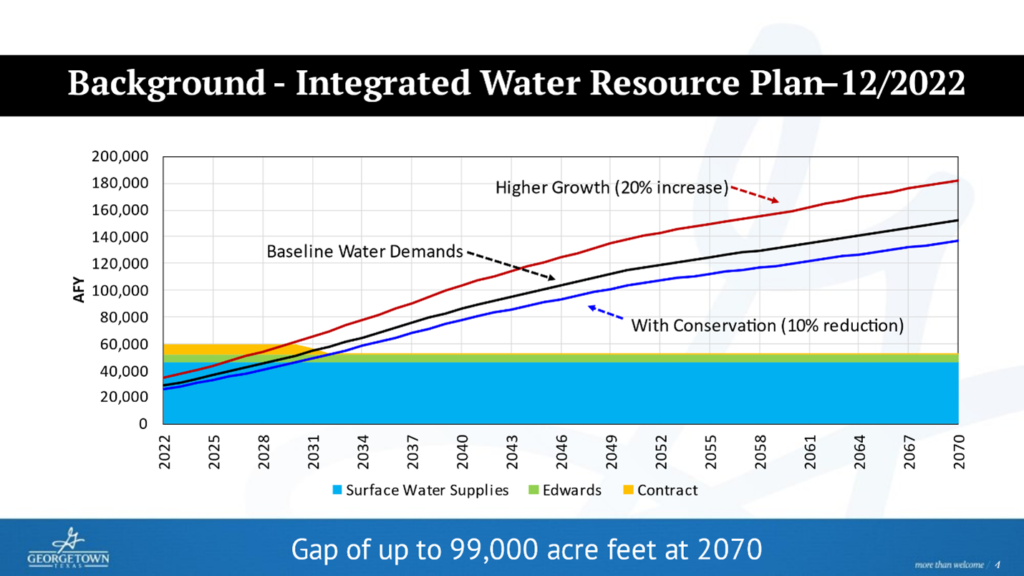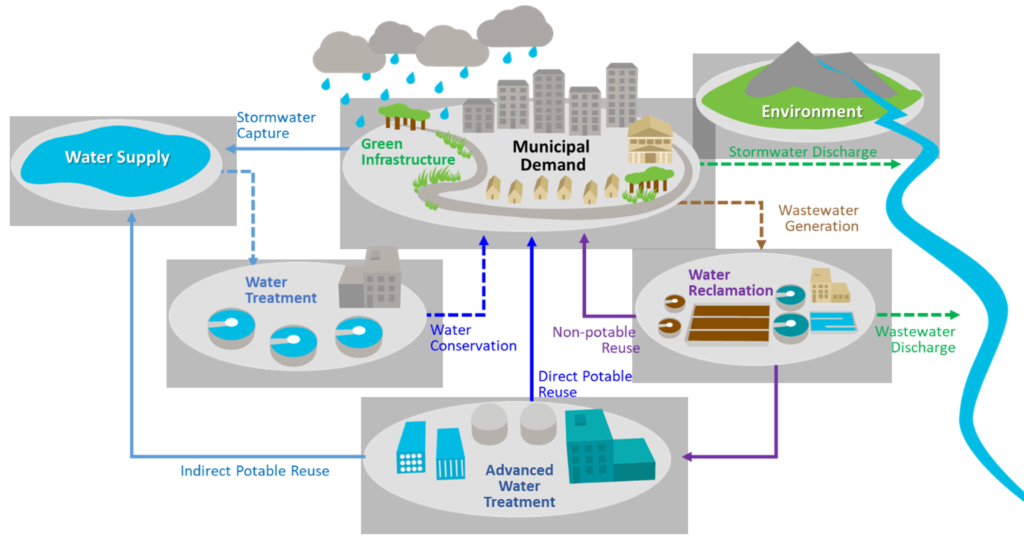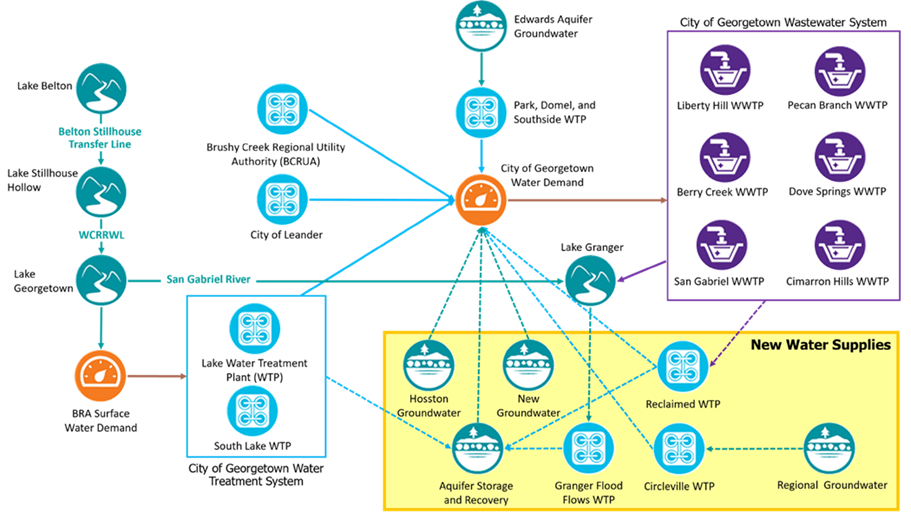
Purpose of the Integrated Water Resources Plan
The City of Georgetown faces unprecedented growth and demand for water coupled with a finite surface water contract volume from the Brazos River Authority (BRA) and limited yield of local Edwards Aquifer groundwater. The population is rapidly expanding in Central Texas, increasing competition for BRA surface water and groundwater supplies. The City initiated the integrated water resources plan (IWRP) to identify new water supply options and ensure long-term reliability under uncertain hydrology and growth. The three principal objectives of the Georgetown IWRP are the following:
-
- Construct and calibrate an integrated systems approach, with water, wastewater, reuse, and stormwater planned together that forecasts water supply needs and takes into account conservation, droughts, regulatory concerns, costs, and timing.
- Identify and evaluate potential water supply alternatives the City can implement.
- Evaluate the volume needed from, and timing for, each supply alternative out to 2070 and associated risks.
The integrated systems approach will help answer critical questions for the City, including the ideal mix of supply alternatives to yield reliability at the most reasonable cost. The IWRP was completed concurrently with other City planning efforts to maintain consistency with water and wastewater master plans. While the master plans look at each system in detail, the IWRP looks at the interrelationships of the system to identify multipurpose and multi-benefit projects.
Read an abridged version of the IWRP here
Read more about where the City gets our water from now and where it will be coming from in this two-page fact sheet.
Project Timeline

Integrated Water Resources Plan Details
Existing Supplies and Projected Supply Gap
The City has contracts about 45,707-acre feet per year (AFY) with the Brazos River Authority (BRA) through lake Georgetown, Lake Stillhouse, and Lake Belton, and an additional 1,200-acre feet of Lake Travis water through the LCRA. The City also has approximately 6,000-acre feet of groundwater from the Edwards Aquifer to help meet demands. Significant future growth in water demand is expected as the population increases. A baseline water demand forecast consistent with other City planning efforts was used in the IWRP analysis.
Water Supply Options
Of the more than 20 water portfolio combinations for new water supply that were considered, there were six portfolios that met long-term supply and sustainability requirements. Successful portfolios included conservation, aquifer storage and recovery (ASR), groundwater, and water reclamation.
Supply Options:
-
- Conservation: Conservation efforts are assumed to reduce the City’s annual demand. Adhering to the watering schedule is vital to ensuring we have enough drinking water to make it through our annual peak season (summer).
- Aquifer Storage and Recovery (ASR): ASR involves seasonal recharge of surplus water. During times when there is spare water treatment capacity and supply, treated water is sent to a wellfield for recharge into the aquifer. Then, during periods of high-water demand or drought, the stored water can be recovered and used to meet demands. ASR is an option in the future: We need excess somewhere in order for ASR to work, so this will be an option when we have more supply.
- Water Reclamation: Excess reclaimed water from the City’s five water reclamation plants can be treated to a higher standard and stored via ASR for future supply needs. This water is already utilized during certain parts of the year for watering of golf courses, parks, and other public facilities. The City is in the process of conducting a reclaimed water master plan to further define highest and best use and to identify additional risks and projects that could be implemented to meet the City’s overall water needs.
- Hosston Groundwater: The City is currently evaluating the ability to utilize up to 12 MGD of Hosston groundwater. Under this option, wellfields and conveyance infrastructure would be constructed to use this supply.
- Regional Groundwater: The City could purchase future regional groundwater supply developed by BRA to be connected and treated near Circleville.
- New Groundwater: The City could try to permit additional new groundwater supply.
- Georgetown Flood Flows: The City could divert surplus, unallocated water from Lake Georgetown to ASR for storage.
- Granger Flood Flows: The City could divert surplus, unallocated water from Lake Granger to ASR for storage.
Water Integration Tool
As part of the IWRP analysis, a systems model was created using the Water Integration Tool (WIT) model developed by CDM Smith. The WIT is designed to simulate changes to surface water, groundwater, and recycled water budgets with changing hydrology or new project implementation. The WIT systems approach is a high-level water supply simulation that is lower in precision but more comprehensive and integrated than models used in master planning and capital improvements project development.
The WIT model used historical hydrology from 1941 to 2013 within the analysis for supply reliability. A 49-year planning horizon from 2022 to 2070 is examined, looping through different potential hydrologic sequences to arrive at a probability for supply reliability and ending period storage for any given forecast year. The WIT model generated the portfolios mentioned in the previous section.

IWRP Findings
- There are multiple supply portfolios that can meet long-term water needs.
- A new raw-water supply must be online by 2030 to avoid supply shortages under current growth projections. The City of Georgetown entered into an agreement with EPCOR on Aug. 9, 2023, to reserve at least 39,399-acre feet of groundwater from the Carrizo-Wilcox Aquifer in Robertson County.
- New groundwater and reclaimed water options best provide supply reliability.
- Reclaimed water is required to prevent supply gaps unless large areas are acquired for ASR.
- ASR is required if regional groundwater is not purchased.
- Conservation efforts should be a part of all future portfolios.












